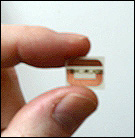RFID tag and reader provider SmartCode has developed its own RFID tags for near field communication (NFC) applications.
“With the interest around EPC, RFID is perceived as a supply chain technology, but there is growing momentum within the consumer electronics market to bring RFID into everyday life,” says Roy Apple, VP of business development at SmartCode, which is based in Tel Aviv, Israel.
Initiated by Royal Philips Electronics and Sony in 2002, NFC technology aims to provide a standard way for a range of NFC-enabled objects and electronic devices to communicate with other devices. The technology has also garnered the support of a host of software, consumer electronics and semiconductor companies, including LG, Microsoft, Motorola, NEC, Panasonic, Samsung, Siemens and Texas Instruments, who have all joined the Near Field Communication Forum founded by Philips, Sony and Nokia.
The goal of NFC RFID is to provide a low-cost short-range form of wireless communications to enable consumers to use the NFC chip built in to their mobile phones and other devices to make electronics payments for various purchases or to use devices with built-in NFC readers to read information stored in NFC-tagged objects. Nokia, for example, already sells an NFC-enabled mobile phone, and other phone and electronics vendors are expected to follow suit with their own NFC-enabled products (see Developing RFID-Enabled Phones).
SmartCode believes its NFC tag, which measures 10mm by 15mm, is the world’s smallest. The tag operates at 13.56 MHz and complies with other NFC standards. Because most of the NFC applications will use the “license plate” method of identification, SmartCode’s tag comes with a 64-bit unique ID number and 96 bytes of user memory. The company says, however, it is also evaluating new NFC offerings with extended memory.
SmartCode believes that by leveraging its experience manufacturing EPC tags and designing small microchips, the company can produce NFC tags that cost less than those offered by its competitors. SmartCode says it can use its existing RFID inlay manufacturing plant in Zhohar, Israel, to produce the NFC tags, although the company will have to recalibrate its machines to produce the smaller tag design.
“We have a special smaller tag design, and our manufacturing process drives a lower tag cost by using our proprietary techniques to produce tags faster than any other company,” says Apple. SmartCode says it has already produced between 1 million and 2 million NFC tags for trials and it will start commercial production in the second quarter of this year.
One of the trials of its NFC tags is being carried out by a partner on nearly 1,000 NFC-enabled posters in London. By positioning an NFC-enabled mobile phone or PDA within 10 cm of one of the posters, a person can download information stored about a specific item advertised on the poster. Information about the specific item featured on the poster will not be stored on the NFC tags but on back-end servers. When the phone reads the NFC tag’s unique ID number, it sends that number to a back-end server database. Based on the tag ID number it received, the server directs the phone’s browser to a URL for a Web site where the requested information can be downloaded. By storing the information on back-end servers rather than on the NFC tag, data can be changed without requiring a visit to the site where the tag is located in order to replace or rewrite the tag.
SmartCode made its debut on the RFID market in April 2003, when it announced that it had a patented process for producing RFID chips that would enable the company to sell RFID inlays for 5 to 10 cents for orders of 1 billion or more units. (See Startup Claims RFID Breakthrough.) Now the company says it has several customers placing order in the tens of millions for its EPC tags and that pricing is less than 20 cents each.
The NFC tags, on the other hand, will cost in “the low-20-cent” range when they are produced commercially. Although SmartCode has developed EPC RFID readers, it says so far there are no plans to manufacture NFC readers.
“We have a reader design, but it’s not for general availability. The NFC tag market is much more accessible for us,” says Apple “We will not sell the NFC readers as a stand-alone product, but as an OEM module for equipment manufacturers. The NFC readers will be available in Q3 2005.”


